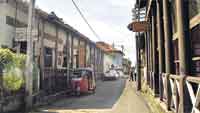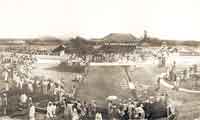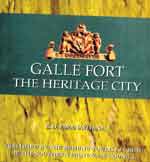| Books |
|
||||||||||
| From a fascination to a study Gall Fort :The Heritage City by K.D. Paranavitana. A little boy of six, from the village of Ginimellagaha, accompanies his uncle to a big town. He is intrigued by the Pachagaha, a huge banyan tree, where knots of people gather to listen to “clamorous alchemists, soothsayers and vendors”. This is also the place where ballad singers use the news of the day to entertain the people with kavi and women sell packets of betel.
The same boy is fascinated by the size of the gigantic ramparts, the extensiveness of the harbour and the diversity of social life in this town. For him “every object that caught my eye in the Fort was new and strange”. That visit in 1950 was not the last. He kept going back even as an adult, and 55 years later his entrancement and wonderment with the town in general and the Fort in particular have come out as a coffee table book, ‘Galle Fort – The Heritage City’. The little boy who stood under the Pachagaha – which he now laments is no more replaced by a large roundabout with a statue of a national hero – whose research has come out in the form of this book is none other than Dr. Karunasena Dias Paranavitana, former archivist and currently lecturer at the Rajarata University.
Calling it a pioneering work, Prof. Senake Bandaranayake pays this tribute: “Dr. Paranavitana is one of a small and distinguished body of Sri Lankan archivists and historians who have specialized in the study of colonial documents and the unravelling of colonial contact history…….While Sri Lanka is rich in publications on its monumental and artistic heritage, especially in studies of its ancient and historic cities such as Anuradhapura, Sigiriya, Polonnaruwa and Kandy, the present book is a pioneering work, documenting in painstaking archival scholarship and a series of visual images the history and the heritage of the fort and harbour of Galle.” Through the pages of this slim book, packed with information, maps and photographs, the author leads the reader down the corridors of time, enlightening him, even those who may have only a scanty knowledge of history, about the importance of Galle through the ages, especially the Portuguese, Dutch and British periods. He does not stop there but also touches on the ravages the tsunami wrought, though negligible compared to other areas, on the Galle Fort.
Although conceding that the book “focuses on nothing but the area of the modern Galle Fort, an icon of national heritage” he spices up the reading with tiny snippets…how Portuguese Captain Don Lorenco de Almeyda, while chasing the Moorish fleet, was driven by the winds and waves and landed in Galle on 15th November 1505 and the legend that says that he approached Galle having listened to the sound of a cock…how the Dutch coat-of-arms of Galle depicts a cock standing on a rock…the Latin word for cock being Gallus and Sinhala for a rock is Gala. Reproducing early maps he goes back in time to show why Galle was considered good to have a fort. Portuguese captain Albegaria had been attracted by the high rock-bound promontory overlooking the natural harbour but the natives had not been too pleased and under the leadership of Vidiye Bandara destroyed the new constructions. However, the persistent Portuguese finally built a stronger fort in 1595 and when they realised that the Dutch were eyeing Galle, strengthened its defences, though an early description calls it “a small affair built of palm trees and mud with only 30 soldiers”. Later the different fortifications in the form of bastions being added by the Dutch who also gradually changed the military atmosphere within the fort by ensuring considerable free movement of people and commodities, and finally the British using it for administrative purposes.
Dr. Paranavitana who has many publications to his credit, embarked on this, on the invitation of the Ruhunu Tourist Board of the Southern Provincial Council. Dealing with each and every aspect of this 17th century fortress built by the Dutch East India Company, utilizing local labour and also local raw material, which is believed to be the largest and most complete walled city in Sri Lanka that still remains a living settlement, Dr. Paranavitana says no one has written about the ramparts before and this is a first. This fortress listed as a World Heritage Monument by UNESCO in 1988, is one of the best preserved fortifications in South Asia. The juxtaposition of the old and the new, using photographs – the black and white photo of the old entrance to the fort with the VOC emblem atop then and the coloured photo of it now; ‘Street Scene from Heydt c. 1744’ and ‘Street Scene 2004 by Bertie Gunasekara’; ‘Cinnamon peeling and bundling –engraving from Baldeus’ and ‘Cinnamon peeling at Meetiyagoda’– throughout the book enhances its readability. For any tourist, be it local or foreign, and for schoolchildren who now have environmental studies as a subject, little tips such as the Akersloot bastion of the fort having the oldest breadfruit (del) tree in Sri Lanka are very useful. No aspect has been ignored, be it churches, warehouse and trade, houses and lifestyle, museums, other places of worship and schools, and helps throw light on the importance of the strong combination of European and native styles which gives Galle fort its flavour today. Having pored over church and official records, Dr. Paranavitana brings out another interesting detail -- that the number of ladies in the Fort increased in the 18th century, with the ranks above Assistant (Civil) and Soldiers (Military) being permitted to get their wives and children to accompany them to Asia on condition that they served an extra period of 10 years, in addition to their usual contract of five. From combs to tobacco boxes, from almirahs to chairs, from the humble waffle maker to the Poffetjes pan (to make tiny pancakes buttered and sugared) that a “burgher huis-vrouw” thought indispensable, Dr. Paranavitana leaves out nothing, making the reader go back into a quaint period and even relish the food produced then…..“The Dutch Burgher ladies made delightful sweetmeats and love cakes. They used local ingredients and condiments as substitutes for originals – cashew instead of almond”, while “South Indian slaves made appa (hoppers) and string hoppers for their masters”. Did you know that Burgomaster chairs were popular among the elite in the 18th century and were distinguished from other chairs by their six legs and rounded back? “This shape though not known in contemporary Europe was nevertheless, very common in VOC settlements in South India and in Sri Lanka. This chair has been considered by furniture historians as a new model introduced with a prudent Indian influence,” he tells us. Can any compilation about Galle be complete without a reference to the first printed word emanating from there? Dr. Paranavitana has in fact published the first page of the first book printed in Sri Lanka way back in 1737 and touches on other ways of communication in British times such as the mail coach service and the pigeon post service. “The old lighthouse on Vlaggeklip Bastion was connected with the pigeon post service between Galle and Colombo initiated by the Observer in 1858. The pigeons carrying mail received by Galle harbour from Europe and America were released from the top os the lighthouse heading for Colombo.”
Reproducing a rare plan of the Galle Fort and esplanade unearthed from the Survey Department and published for the first time, Dr. Paranavitana proves that the open land in front of the Fort was used as an esplanade. The term esplanade means that it was the turf prepared for horse racing similarly as Galle Face Green. As is fitting, he winds up by detailing how the mighty ramparts of the fort withstood the deadly tsunami, with only Akersloot and Aurora Bastions suffering slight damage. Even the damaged parts of the rampart are not original masonry work of the 17th century but recent repairs, he says giving the reader a vision of what the Galle Fort would have been at its zenith. For anyone this work would be a valuable addition to their libraries or their bookshelves, even if they do not proudly display it on their coffee table.
‘Do this, do that’, is not the way to do it Communicating With Children and Connecting With Children in the Classroom by Bonnie Miller. “Your room looks like a pigsty. You should be ashamed of yourself.” How often do we hear parents say words like this with little or no effect? Where do we go wrong? “The “you” statement assigns the problem to someone else and puts your child on the defensive,” explains psychotherapist Bonnie Miller. The author recommends a different way of handling the problem by using the “I” statement. “Son, I want you to know that I’m feeling badly about the way the house has looked lately. I try hard to make this a home we can all be proud of. I’m also tired after work and I don’t need additional work. What I do need is some help from you in keeping your own room cleaner. Could you help me out and keep your room more tidy? I’ll help if you want me to and I’m available. Okay?” she suggests. Bonnie Miller’s manual “Communicating with Children” that can help parents enhance, improve and enjoy their relationship with their children (Sinhala and Tamil versions), jointly published by Plan Sri Lanka and The Sri Lanka Foundation Institute was launched at a brief ceremony at the SLFI on May 18. Raising a child is hard work, said Ms. Miller. There is no manual as when buying a TV or a mobile phone. Nor are there any rules, guidelines or exams one must pass to obtain a certificate that qualifies you for the most important job of being responsible for a child’s life. “No matter how people were raised twenty
or thirty years ago, they did not face the daunting challenges that
parents and children confront today,” she says, referring
to the increased scholastic demands, the lure of drugs, materialism,
fear of terrorism and other pressures that are a part of young lives.
“If this book gives support to one parent to help raise one child, it would have been worth writing,” Bonnie Miller says emphasising that we can make an enormous difference in our children’s lives. “Connecting with Children in the Classroom,” Bonnie’s manual for teachers was also launched on the occasion. The 200-page teacher handbook supports educators in meeting the challenges of 21st century education, outlining effective methods they can employ. Ms. Millers points out that our rapidly changing technological society is creating new and varied jobs that require workers to access and apply information, use critical thinking and solve problems. “Teachers can no longer rely on information or teaching methods that they learned decades ago; they must constantly update their knowledge to provide a learning environment that fosters these competencies,” she adds. Having worked for around 35 years as a social worker, educator, social activist, trainer in addition to being a psychotherapist, she is well aware that children want humane teachers who can connect with them, understand their needs, nurture their creativity and teach according to their individual learning styles. To survive and thrive in the modern world, Ms. Miller thinks, children need to acquire not only knowledge but also skills. Success at workplace depends on the ability to relate to people, be a team player and a good manager, to be aware of one’s own emotions and sensitive to those of others, to communicate effectively and to solve conflicts. Such skills evidently are essential in everyday life in relating to family, peers and later to spouses and children. “Teachers can be extremely important in helping children acquire these competencies all through their school years.” “Teachers can use their own ingenuity to adapt the pages of the book to their own classroom and students,” Ms. Miller states. The chief goal would be to create classrooms that are rich and interesting environments that motivate children to be curious about the world and to become committed to lifelong learning. Working in post-war Bosnia in 1970, Ms. Miller was dealing with trauma in children when she felt the need for a manual on ‘raising children’ for parents of all three warring factions – the Croats, Serbs and the Bosnian Muslims. Taking resources from the American parenting programmes and the research-tested and proven techniques in helping parents communicate with children, she published this book that was later translated into Greek, Albanian, Turkish, Chinese, Bosnian, etc. When the Education Minister in Bosnia requested a similar manual for teachers, she wrote the book ‘Communicating with Children in the Classroom’. The local translator has adapted the books slightly to make them culturally appropriate.
Lessons on life with a lively touch Street Sweeper-Short stories for children by P.K. Rajaratnam. P. Kandhapu Rajaratnam explores the journey of creative writing in his anthology of short stories “Street Sweeper”, taking the reader through a series of experiences about growing up. The short stories featured in this compilation are intended for children and contain enough entertainment to lighten the lessons of life that they convey. Each story is inclusive of a moral. “A Street Sweeper” speaks of a young girl, Geetha who is distressed by her mother’s occupation as a street sweeper. She wonders if there is any dignity in such a profession. Her mother speaks to her of the importance of a street sweeper’s work and Geetha begins to appreciate the pride that her conscientious mother takes in her work. “Think Before You Leap” speaks of the relationship between a fox and a crow where the fox takes advantage of the crow’s naiveté. The crow is warned by everyone not to have a relationship with as cunning an animal as a fox and yet, the young crow continues his friendship. The story goes on to say how the fox exploits the labour of the young crow in their ventures and how the crow finally comes to terms with the extent of his own gullibility. “A Reformed Thief” introduces a man who is involved in serious crimes that disrupt the peace and security of a village. Once, when a policeman pursues him, he seeks refuge in a temple where a group of devotees are singing the praises of God. The thief pretends to be one of the devotees to escape the law but the police eventually catch him. The story goes on to say how the thief escapes prison and becomes a true worshipper. The stories featured in “Street Sweeper” are all presented in a localised environment and reach out to young children. They are rich in character and narrative and consist of familiar themes. Illustrations and vibrant conversation found in the stories serve to make this anthology an interesting read for children. |
|||||||||||
Copyright © 2006 Wijeya Newspapers
Ltd. All rights reserved. |



